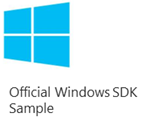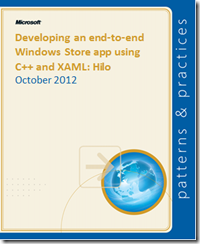Developing a Windows Store app using C++ and XAML: Hilo guidance released
The patterns & practices client team is happy to announce the release of the Hilo guidance: Developing a Windows Store app using C++ and XAML which is part of the Windows SDK. This is companion guidance for Hilo JavaScript.
Customer Value
Windows 8 enables millions of people to be more productive, creative, and to have fun. The combination of C++ and XAML opens up a new world of development practices for creating apps.
This guide is based on the experiences of a fictitious team that created a photo browsing and editing app named Hilo. This guide focuses on how to create a world-ready app that combines the power of C++ with the controls and features provided by XAML to create an app that looks and works great on both touch and non-touch devices. Hilo includes support for four languages and all world calendars, and can be easily modified to support any language.
It is intended for any architect or developer who designs and builds Windows Store apps. This guide demonstrates how to write modern C++ and XAML code using async programming patterns to build Windows Store apps that use tiles, a splash screen, controls, pages, navigation, suspend & resume, and touch. The guide provides common guidance on common development patterns and practices such as Model-View-ViewModel (MVVM) and Repository patterns and unit testing.
Acknowledgements
We want to thank the customers, partners, and community members who have patiently reviewed our early content and drafts. We especially want to recognize Marcelo Hideaki Azuma (ITGROUP), Chad Carter (CTO, GlobalCove Technologies), Tony Champion (Owner, Champion DS), Carlos dos Santos (CDS Informática Ltda.), Genevieve Fernandes, Alon Fliess (Chief Architect, CodeValue), Timo Heinäpurola, Tim Heuer, Robert Hogg (Black Marble), Hong Hong, Mike Kenyon (Senior Principal Software Engineer, IHS, Inc.), Artur Laksberg, Michael B. McLaughlin, Harry Pierson, Caio Proiete (Senior Consultant/Trainer, CICLO), Andy Rich, Martin Salias, Herb Sutter, Jose Miguel Torres (Software Engineer, Xamarin), and J. Andre Tournier (Sr. Software Developer, WebMD) for their technical insights and support throughout this project.
We also want thank the Microsoft team:
- Program Management: Blaine Wastell
- Development and written guidance: David Britch (Content Master Ltd.), Bob Brumfield, Colin Campbell (Modeled Computation LLC), Scott Densmore, Kate Gregory (Partner, Gregory Consulting), Thomas Petchel
- Test: Swetha Dyachavaram (Technology analyst, Infosys Ltd.), Carlos Farre, Rohit Sharma, Aviraj Singh (Sr. Technology Architect, Infosys Limited)
- UX and graphic design: Deborah Steinke (Graphic Designer, adaQuest, Inc.), Howard Wooten
- Editorial support: Marzena Makuta, Mike Matteson, John Osborne, Kristi Rasmussen
What’s in the box
The reference implementation illustrates the concepts for developing Windows Store apps.
 |
 |
 |
The guide Developing an end-to-end Windows Store app using JavaScript: Hilo complements the reference implementation e by describing how it works and what decisions were made during its development.
How to get it?
The reference implementation is available from the MSDN Code Gallery at https://aka.ms/hilocpp-code. The associated guide is available on the Windows Dev Center at https://aka.ms/hilocpp-doc or as a PDF. The documentation on the Windows Dev Center has been localized into the following languages:
- Chinese Simplified
- Chinese Traditional
- French
- German
- Italian
- Japanese
- Korean
- Portuguese
- Russian
- Spanish
- Ukraine
How to get started?
There are many ways to get started with Hilo. One way is by reading the guide which includes a Table of Contents. We provided the Table of Contents to help you understand the breadth and depth of the guide. Depending on your experience creating Windows Store apps you will want to read the guide from start to finish or read how we implement specific features.
Another way to get started is to download the RI which is an official Windows SDK sample. The Getting Started chapter describes how to build and run the code and provides a description of the different project and solution folders. You can download the associated unit tests from CodePlex site at https://hilo.codeplex.com.
Your turn
After reading the guide or reviewing the code it is now your turn to create a great maintainable and testable app. Let us know how it is going and what additional guidance is needed. You can leave us feedback on the https://hilo.codeplex.com community site. We hope Hilo helps you succeed.
